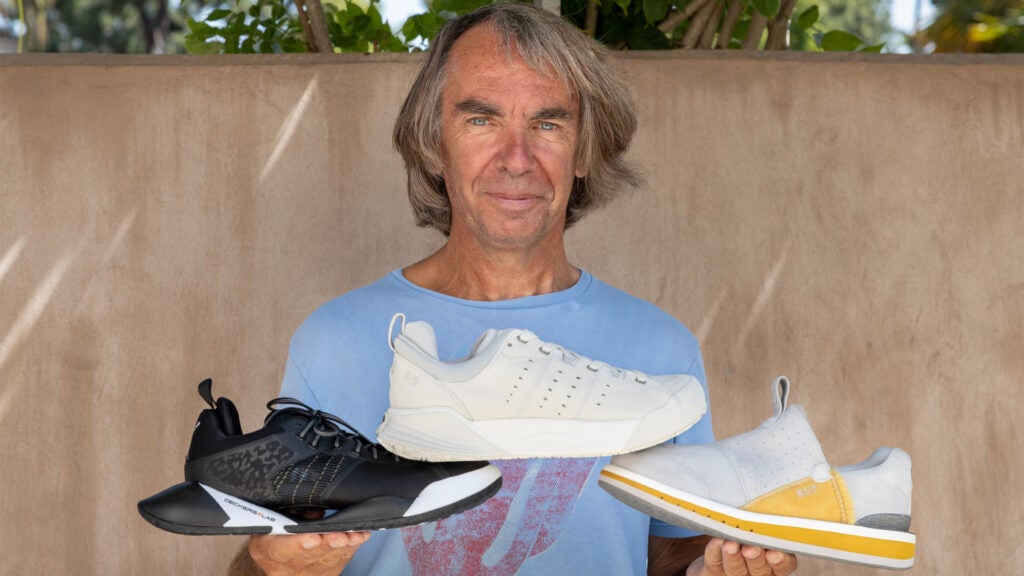No products in the cart.
Outdoor Adventure
The Mastermind Behind Your Favorite Shoes Is About to Disrupt the Shoe Industry. Again.
Diard’s garage wall dons a homemade rack system that holds hundreds of shoes—his own prototypes and models from various brands. In front of the shoes sits a forest green Porsche Macan, which he drives through the winding, eucalyptus-lined streets of swanky Montecito to get us to the Romero Canyon Trailhead, one of his favorites. Due to his early-morning meetings with Europe and his late-night meetings with Asia, Diard’s workweek runs consist of midday test loops around the concrete office park in Goleta. On weekends, however, he heads out for six-to-nine-hour product-testing trail runs.
On the three-mile, 1,500-foot climb up Romero Canyon—where we’re both wearing X Lab prototype trail-running shoes embedded with plates of some sort (he won’t tell me what material the plates are made of) and waist belts that wear more like a girdle than any others on the market (“to lay flat on the body”)—we talk about how a global view on product, business, and life is important. How adventure racing, with its multiple disciplines, is sort of like a 30,000-foot view on product development. How having employees in their twenties provides fresh perspectives on business. “I always hire young people who do many sports,” he tells me. He is always searching for another way to understand a product.
Most of his ideas come while he runs, so he has taken to recording voice memos of his thoughts on his phone as he goes. “Because you are there, you run, and things kind of sink in some ways,” he says. “They digest naturally, and all of a sudden—pop! bop!—you have something.”
At the top of the climb, Diard and I swap shoes (we have the same size foot). He sometimes runs with a second pair in his backpack, he says, and switches them midway or runs with one model on one foot and one on the other.
On the descent, we talk more about the super sneaker, a category that he doesn’t believe exists yet. He says he loves the idea of general consumers as well as colleagues at Hoka thinking, Oh, I didn’t know I needed that, but now that I have it, it fully makes sense. Or just that they’re cool. When I arrive home in Colorado wearing an all-white prototype of what has since been released as the Hoka Transport X, my budding sneakerhead 14-year-old son gives me a, “Yoooo, those are sick!”
Sometimes Diard’s presentations to Hoka go so well that the brand decides to roll a Deckers X Lab shoe into the Hoka line. When I visited, Diard wasn’t sure whether the prototype shoe would come to market under the Deckers X Lab label or be adapted in some form by Hoka. When I asked him if he’d rather get credit for industry-changing designs, he just shrugged and smiled. He does, however, admit that it’s sometimes hard to let go. “There’s always that little moment of handing over the baby,” he told me, laughing.
Hoka, as a brand, seems to benefitting greatly from the resources of Deckers, sure. But also from Diard’s ongoing innovations and ability to think five steps ahead, his internal compass leading him to push boundaries in areas of design, materials, and categories. Diard, in turn, seems to be benefiting from having generous funding from Deckers for a 3D-printing lab, and a team of engineers and designers around the world, and the green light to basically keep playing around.
In fact, Deckers is so impressed with the Diard’s work on the Transport X that the company is planning to launch an entirely new brand around the concept, to be announced this fall. With that, Diard is on to the next thing—which he couldn’t share with me. At least not yet.
It might not be a perfect idea. It might even be a mistake. “But,” he says, “it’s a permanent quest.”
Source link

